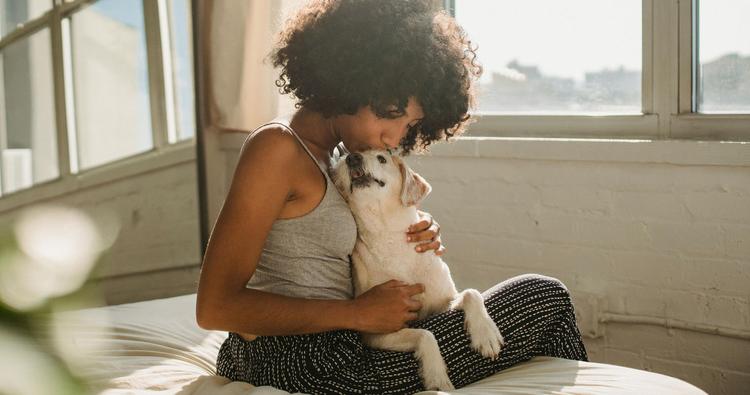Do Puppies Outgrow Separation Anxiety?
Here are nine things you can do to help your dog be less anxious in your absence.
Here are nine things you can do to help your dog be less anxious in your absence.
by Katie Koschalk, | October 10, 2024

Karolina Grabowska / Pexels
If you’ve recently adopted a puppy, and it seems like they’re struggling with separation anxiety, you’re probably wondering if they’ll ever outgrow it. It’s a tough situation when your pup becomes stressed every time you leave, and finding ways to ease their discomfort can feel like a long road. While most cases of separation anxiety in puppies don’t go away entirely, the good news is that with the right strategies and support, many anxious pups can learn to handle alone time more peacefully.
We spoke with dog trainers to understand the ins and outs of separation anxiety in dogs and discover ways to help your anxious companion feel more relaxed when their favorite person is away.
Separation anxiety is a common behavioral issue in dogs. It occurs when a puppy (or adult dog) becomes overly distressed when left alone, often resulting in problematic behaviors. This anxiety stems from the puppy’s natural instinct to seek protection and comfort from their pack — which, in this case, is you and your household.
Puppies may feel insecure in their new environment. They’re suddenly navigating a world that’s unfamiliar and potentially overwhelming. The fear of being left alone can trigger anxiety, causing them to act out in ways that express their discomfort and fear.
Recognizing the signs of separation anxiety in puppies can help you address the problem early on. Common indicators include:
Excessive barking or whining — vocalizing excessively when you leave the room or house
Destructive behavior — chewing on furniture, scratching doors, or destroying household items in your absence
Pacing or restlessness — repetitive pacing (often in circles or back and forth near entryways) when they realize you’re preparing to leave
Accidents indoors — urinating or defecating inside the house, even when they are house-trained
Attempts to escape — trying to dig, scratch, or chew through doors and windows to escape confinement
Drooling or panting — excessive drooling or panting that occurs when they’re left alone
Shaking or trembling — shaking that occurs due to heightened stress or fear of being apart from their human
Loss of appetite — refusing to eat or drink when they are anxious about your departure
Separation anxiety often starts in puppyhood and typically develops due to a combination of factors, below.
Puppies form strong bonds with their caregivers as a survival instinct, which helps them feel safe and secure in new environments. Generally, a bond between a new puppy and their pet parent can form within the first few days to a few weeks, says Melissa Bartoli, certified shelter staff dog trainer with Abandoned Pet Rescue. But, she adds, it may take several months for a deep, lasting connection to fully develop.
While attachment is an important part of a dog-human relationship, separation anxiety can arise when a puppy becomes overly dependent on their caregiver. If a puppy hasn’t learned to feel comfortable being alone or with other people, they might struggle with anxiety each time you’re out of sight.
“Trauma, fear, or instability during a puppy’s formative weeks can create a sense of insecurity, which may manifest as separation anxiety later in life,” Bartoli says. Experiences such as rehoming, abandonment, or abuse can set the stage for future anxiety-related behaviors, including separation anxiety.
Puppies who aren’t exposed to a variety of people, pets, and environments during their critical socialization period (between three and 14 weeks) may struggle with confidence and independence. This can make them more vulnerable to stress when they’re left alone.
“Changes in routine can trigger or worsen separation anxiety in dogs since dogs thrive on routine and predictability,” Bartoli says. “Any disruption to their regular routine may lead to separation anxiety, even in dogs that previously had no issues being left alone.”
This may include things like new work schedules, moving to a new home, or changes in household members, says Sally Gutteridge, a certified dog behaviorist and founder of The National Institute for Canine Ethics.
No, it’s a common misconception that dogs naturally outgrow separation anxiety as they age. While some puppies eventually stop whining and barking when left alone, it’s often not related to separation anxiety.
Often, what young dogs experience when they’re first separated from their humans is frustration or boredom rather than true anxiety. They’re adjusting to being apart from their littermates or human companions. This frustration can decrease over time as they learn to entertain themselves or relax in your absence.
To determine if your puppy’s behavior stems from frustration or from anxiety, pay attention to when the behaviors occur and how long they last. If your pup calms down fairly quickly after being left alone or shows only mild signs, it’s likely frustration, which they’ll likely outgrow over time. However, if your dog’s distress continues long after you’ve left and escalates to extreme behaviors, like destructive behavior, incessant pacing, attempts to escape, or even self-harm, they’re likely suffering from separation anxiety.
“It’s crucial to understand that while some dogs may show improvement over time, separation anxiety typically requires intervention,” Bartoli says. “It’s not a condition that resolves naturally without help, so it’s important to take action.”
How do you address this problem and help your pup feel more at ease in your absence? Here are nine things you can do.
Bartoli suggests you begin by leaving your puppy alone for short periods (just a few minutes), and gradually increasing the time as they become more comfortable. Pair these periods of separation with positive reinforcement, like giving them a treat or favorite toy before you leave, to create a positive association with being alone.
Crate training can be a valuable tool to help puppies with separation anxiety. When introduced correctly, a crate offers a safe, den-like space where your puppy can feel secure, Bartoli explains.
Make the crate a positive place by adding comfy bedding and giving your puppy treats or puppy-safe toys when they go inside. Gradually increase the time they spend in the crate while you’re home to help them feel comfortable, before leaving them alone.
Crate training should never be forced or used as punishment. The goal is to help your puppy associate the crate with safety and relaxation, which can ease their anxiety during your absence.
Gradually expose your puppy to additional triggers of their anxiety in a controlled way. For example, if your puppy becomes anxious when you grab your keys or put on your jacket, practice doing these actions without leaving. Over time, your puppy will begin to disassociate these cues from your departure, easing their overall stress.
Set your puppy up for success by giving them enrichment toys — such as puzzle feeders or stuffed Kongs — when you leave. This can keep them entertained and distracted during your absence.
As tempting as it may be, making a fuss when you leave or return can heighten your puppy’s anxiety. Instead, keep arrivals and departures low-key. This teaches your puppy that your coming and going isn’t a big event, helping reduce the emotional build-up and reactions surrounding these moments.
Regular feeding times, walks, play sessions, and alone time create a sense of predictability that helps your puppy feel more secure. If possible, stick to a routine, even on weekends, to avoid confusing your puppy.
By keeping things consistent, you can help your puppy understand that alone time is just a normal part of the day and that you’ll always return, easing their anxiety in the long run.
“Regular physical exercise and mental stimulation (e.g., training, play) can help release pent-up energy and make the dog more relaxed when it’s time for you to leave,” Bartoli says.
If your puppy’s separation anxiety is severe or not improving with the above strategies, seek help from a certified dog behaviorist or trainer. They can create a tailored plan to address your puppy’s specific needs and provide additional support through behavior modification techniques.
You can search for a dog trainer on the Certification Council for Professional Dog Trainers’ website by plugging in your zip code. Additionally, your veterinarian, local shelter, or pet-parent friends may also know certified trainers with good reputations.
If your puppy’s separation anxiety persists or worsens despite training efforts, it’s important to take your puppy to a veterinarian. They can rule out any underlying medical conditions that might be contributing to your pup’s anxiety and provide guidance on behavior modification strategies In some cases, your vet may recommend supplements or medications to help manage your puppy’s anxiety.
No, ignoring a puppy with separation anxiety can make it worse. Instead, focus on building their confidence by gradually increasing alone time, providing enrichment, and using positive reinforcement when they remain calm.
Letting your puppy sleep with you doesn’t directly cause separation anxiety. However, fostering independence during the day is important to prevent reliance on your presence, which can help manage separation-related behaviors.
Yes, crate training can help by creating a safe, comforting space for your puppy. When introduced properly, a crate becomes a safe space that can reduce anxiety during alone time, but it should always be paired with positive reinforcement.
According to Gutteridge, resolving separation anxiety issues in puppies is comparatively easier than in adult dogs because the older the dog, the more ingrained their behavior and experiences are. However, reducing an adult dog’s separation anxiety is still possible.
While getting a second dog can sometimes help by providing a distraction, it doesn't always solve separation anxiety. This is because the anxiety is often tied to being apart from their human, not another dog. Training and gradual desensitization tend to be more effective.
While separation anxiety in puppies and adult dogs typically doesn’t go away completely, this behavior can improve significantly in dogs with consistent training and desensitization.
Canine Separation Anxiety: Strategies for Treatment And Management

Katie Koschalk is a freelance writer based in Northern California. Fusing her love and knowledge of animals with her journalism degree and years of professional writing, Katie is dedicated to improving the lives of pets and their caretakers by sharing helpful and accurate information. When she’s not at her desk, you can find her exploring trails with her Aussie, Hunter, cooking plant-based meals, and talking to her two cats, Jax and Sadie, in really ridiculous voices.

Behavior & Training

Behavior & Training

Behavior & Training

Behavior & Training

Behavior & Training

Behavior & Training
Does your dog experience separation anxiety? Explore helpful techniques to comfort and entertain your dogs while they

Behavior & Training

Behavior & Training

Behavior & Training
Does your dog get overstimulated easily? Here’s what you can do to help calm an overstimulated pup.

Behavior & Training